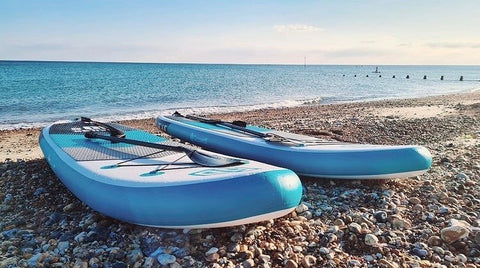Taking Care of Your Inflatable SUP
Table of Contents
1. Keep Your Paddle Board Out of Sunlight
2. Store Your Board Properly
3. Transport Your Paddle Board Gently
4. Keep Your Paddle Board Clean
5. Dry off Your Paddle Board After Use
6. Be Careful While Padding in Shallow Water
Paddle boarding is a great hobby to keep you occupied during the heat of summer. inflatable paddle boards are also an investment. The outdoor elements can wreak havoc on your SUP if you’re not careful, so taking care of your SUP board is crucial to ensure it lasts for many years and provide you with extra years of paddling.
It doesn’t take much time or effort, but it’s certainly worth it. By taking the following tips into consideration, you will be well on your way to prevent these and other elements from harming your beloved paddle board.
Keep Your Paddle Board Out of Sunlight
Paddle boards are do designed for outdoor use, but it doesn’t necessarily mean they can be in the outdoor elements for long periods of time. Use it and enjoy it on the water all you want. However, you need find cool shaded storage or cover from hot sun when not in use on the water to expand its lifespan.
The sun will heat up the air inside, causing your inflatable paddle board to expand. Once it expands, the higher air pressure can lead to the paddle boards seams bursting. Another damage that sunlight can cause is loss of color, it can fade the pretty colors of your paddle board very quickly.
If you do not want this taking place, try to store your paddle board in a shady cool place, away from direct sunlight whenever you aren’t padding.

Store Your Board Properly
Proper storage is extremely important when it comes to paddle boards as improper storage for long periods can have its effects. Don’t store it on the floor. Try to get a rack so that the bottom edge of your board does not get affected by dirt, dust, and debris. The best places to install your paddle board rack would be in a cool, dry area, such as a garage, shed, or even under your deck.
If you have a lot of space to store in your house, and you´re not going to use the SUP in a long time we recommend to keep it without deflating it: half pressure (10 PSI). Note: don’t stack anything on top of it, even light items. Your inflatable paddle boards can get pressure dings. For more paddle board storage ideas, please check out our article.

Transport Your Paddle Board Gently
Most SUP boards nowadays come with a backpack so it’s very easy to carry from place to place. For long journeys by car we recommend you deflate the air and pack it in the bag, which can keep it out of direct sunlight. For shorter journeys, it’s suggested that you transport it with roof pads and straps.
SUP Boards should be face down with the fin at the rear of the vehicle and the fin upwards. Make sure the straps are tight, but not so tight as to cut into the board.
When carrying your board to and from the water, make sure that you never drag it. All the seashells, stones and tarmac will damage the board eventually, and, if you're unlucky, they will puncture your SUP.

Keep Your Paddle Board Clean
Regular cleaning of your SUP will keep it looking vibrant. We recommend using a brush or cloth and a mild cleanser like dishwashing soap. When you are rinsing your board off, pay special attention to the fins, valves, attachments, handles and D-rings. Any crease, corner, or seam is an opportune place for build-up.
You do not need to rinse your board after using it each time if you are paddling in fresh water, unless you want to quickly clean off debris. However, if you are paddling in salt water, always rinse your SUP board with fresh water to wash away corrosive salt water.
Otherwise, the saltwater can dry out and start eating away at the materials of your board. For inflatable SUPs, it can weaken the seams, eventually causing the board to break.

Dry off Your Paddle Board After Use
Once your board is rinsed, it’s time to dry it off. If not, mould and spores can form both on the board and inside your carry all -- the latter being a real breeding ground for bacteria.
The best option would be to leave it in an open and ventilated place, as maintaining the humidity in will let mold grow and leave marks. Don’t store it until it’s well and dry. That way, when you use it again it will be like the first day you took it out of the box.
Be Careful While Padding in Shallow Water
Be careful of the surroundings and the environment of your paddle board while padding in shallow water. Sure your board is only a few inches thick, but it can be easy to forget that there is a 10-inch fin beneath your paddle board. If your fin catches on something in shallow water like a rock, you will stop instantly and likely fall right off the front of the board. We all know that falling in less than 10” of water can be really dangerous!
In addition, often when a fin box is damaged it cannot be repaired. That means your paddle board is ruined. Thus, make sure the water is deep enough when you get on your board and stay clear of shallow water as far as possible.

You may spend a lot of money on buying a good paddle board. But if you don’t maintain it properly, then you will end up with a worthless board very quickly. It makes sense to spend a little extra time to take good care of your investment. Following these care and maintenance recommendations will extend your board’s lifespan and enjoy many long hours of paddling fun into the future.










